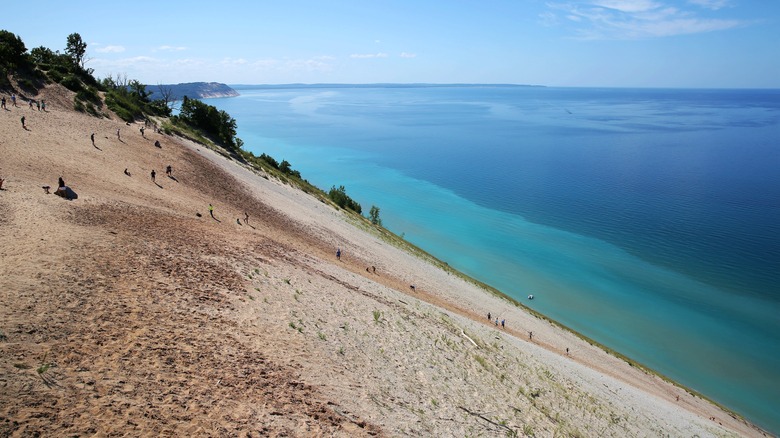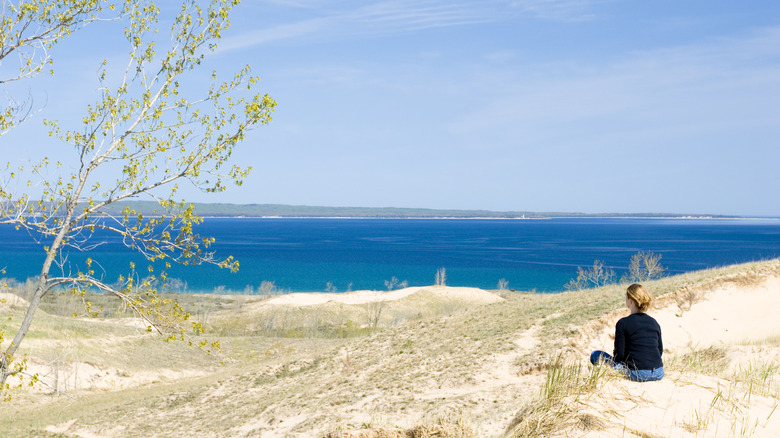This Mortifying Mistake Can Cost You Thousands At An Iconic Midwest National Park
You might associate sand dunes with a desert oasis — not a midwestern state — but Michigan boasts what could be considered some of the most jaw-dropping dunes in the country. According to the National Park Service, over 1 million people visit the state's Sleeping Bear Dunes National Lakeshore each year to see its stunning sandy bluffs overlooking Lake Michigan. One of the most popular sites is the 450-foot-tall No. 9 Overlook with a steep drop to the coastline below.
From the top, the sloped dune can appear easy to slide down and climb back up, but this assumption is a common mistake. As one of the park's rangers explains in a National Park Service video, it can take two hours to make it to the top after reaching the base. Even worse, some hikers can't complete the climb without calling for a rescue squad.
Besides being embarrassing and potentially dangerous, failing to make it back to the top alone can also be expensive. A viral TikTok posted by user @chef_meff showed a sign posted at the dunes warning hikers of a $3,000 fine for rescue services, followed by footage of visitors struggling on all fours to make it up the sand bluff.
Rescues are complicated and costly
If $3,000 sounds like a lot just to be pulled up a dune, keep in mind that rescue operations at Sleeping Bear Dunes aren't always easy. Park Ranger Andy Blake told UpNorthLive that a rescue mission can require multiple teams. "It's not just the National Park Service," he shared. "We have Leland Fire, Cedar Fire, Glen Lake Fire, Homestead Fire Department, Frankfort Fire Department." Blake added that it's the fire departments, not the park itself, that charge for rescues, which explains why some stranded guests are forced to pay the hefty fine.
If the charge still sounds unreasonably high, note that rescue services can be complicated, involving ATVs, UTVs, ropes, and rescue baskets. When the lake water is high and there's no beach at the base of the dune, the fire department may also utilize boats to complete rescues, as Glen Lake Fire Chief Bryan Ferguson told MLive.
These tactics may seem extreme, but they're not uncommon. In 2014, the Friends of Sleeping Bear Dunes reported 31 search and rescue missions and 56 emergency calls from the Lake Michigan Overlook area between Memorial Day and Labor Day. However, the number of emergencies has dipped, thanks to volunteers stationed at the site. For the same period in 2023, there were only 11 search and rescues and seven emergency calls.
If you plan to climb the dune, come prepared
If you're heading to Sleeping Bear Dunes National Lakeshore and plan to go swimming in Lake Michigan, make sure you're fully prepared before hiking to the bottom of the dunes. The National Park Service suggests bringing gear needed for a day at a national park, including shoes and a bottle of water, before starting your trek. Once you're at the dune, avoid injuries by walking down slowly and sticking to the marked hiking trails. If you get tired during your climb, listen to your body and take breaks to avoid becoming fatigued.
Be mindful of the weather and water conditions before your visit, too. On hot days, the sand can be scalding (up to 150 degrees Fahrenheit), and you could risk burning your skin during the strenuous hike. Water levels can also greatly impact your visit: High waters can make it harder to get back on land, while low waters provide more escape routes (such as through North Bar Lake in the direction of Empire).
Remember, Sleeping Bear Dunes National Lakeshore is worth the trip even if you don't make it to the bottom of the overlook. Grab a bike or some skates and cruise the Sleeping Bear Heritage Trail, accessible from multiple roads in the park. Alternatively, explore Glen Haven, a historic village featuring a vintage general store, boathouse, and blacksmith shop, along with easy access to the beach.

